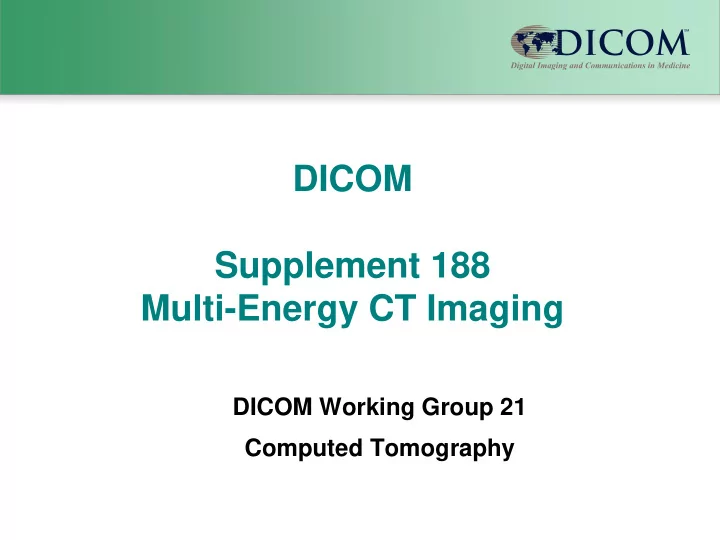

DICOM Supplement 188 Multi-Energy CT Imaging DICOM Working Group 21 Computed Tomography
Rationale Short introduction of Multi Energy (ME) Images Overview: • Imaging techniques, including scanning, reconstruction, processing, when the scanner utilizes multiple energies from the X-Ray beam spectrum, as opposed to the conventional CT imaging, when a single (accumulated) X-Ray spectrum is used. • The existing CT and Enhanced CT (eCT) IODs do not adequately describe the new CT multi- energy imaging. Although different vendors apply different scanning and detection techniques to achieve multi-energy images, there is large commonality in the generated diagnostic images. Goals for ME Image implementation: • provide new essential ME information (acquisition, reconstruction and processing attributes) within the IOD. • facilitate fast and easy adoption of standard based ME imaging across the imaging community, both modalities and PACS/Displays. • address (or at least to minimize) the risk of mis-interpretation when the ME images are displayed by a display does not support the new attributes of the ME-image, including incorrect measurements • adapt existing attributes of the CT / Enhanced CT IOD to fit ME techniques. 2
Overview Multi Energy Imaging Standard Material Objective Material Material CT Image Visualization Image Quantification Labeling Family Family Family Family Virtual Mono- Material- Discrete CT IOD Other IOD Specific energetic Labeling Image (VMI) Image Image Material- Color Overlay Iodine Map; Modified Image Bone Density Effective Atomic Image Probability Number (Z) Highlighted; Map Image Image Material- Color Partially- Blending Removed Suppressed Image Image Electron Density Value based Virt. Non- Image Contrast; Map Image Color Map Virt. Non-Ca; Gout crystals Image Proportional Map Image
Organization Structure Multi-energy CT Macro ( new added to CT IODs ) • Multi-energy Flag (Y/N) • Multi-energy CT Acquisition Sequence (1C, 1 item) • Multi-energy CT Acquisition Sequence (1-N) – Multi-Energy Source Technique – Multi-Energy Detection Technique – Other ME-specific attributes – Common CT Acquisition Macro • Multi-energy CT Processing Sequence (1C, 1 item) • Decomposition Method • Decomposition Basis Sequence (2-N items, one for each basis) • Other decomposition attributes • Multi-energy CT Characteristics Sequence (1C) • Monochromatic Energy Equivalent ( for Virtual Monochromatic Image ) • Multi-energy Quantification CT Image Macro – Specific Material Code Sequence – Material Modification Sequence • Multi-energy Labeling CT Image Sequence (1 item) – Material Labeling Type – Material Modification Sequence 4
Multi-Energy CT Acquisition Techniques Scanned X-Ray Source Detector Object Generating different Discriminating X-Ray Energies : Energies : Multiple Photon KVP Filter Other Layers Counting Parameters Methods to separate at least two energies include – Multiple Scans of the same area with diff parameters – Multiple X-Ray Sources and/or Detectors – Switch KVP during the rotation – One source with Multi-Layer Detector – One source with Photon Counting Detector
“Objective” Images Decomposition to Generation of Data Acquisition Base Components Diagnostic images Virtual A1 M1 Monochromatic M2 Effective A2 Atomic Number … … Mn Electron An Density Described in ME CT Described in ME CT Described in ME CT Acquisition Sequence Processing Sequence Characteristics Sequence (currently just keV for VMI)
“Material” Images Data Decomposition to and/or Classification of Generation of Acquisition two or more Materials Diagnostic images Material Quantification Family A1 M1 Material Labeling M2 Family A2 … … Material Mn An Visualization Family Described in ME CT Described in ME CT Described in ME CT Processing Sequence Characteristics Sequence Acquisition Sequence
Material Images Generation Material-Specific Image Examples: : M1 - Iodine Map - Bone (Ca) Density Map Proportional Map Image M2 May be ignored / Material Labeling Images Not described Mn Material- Examples: : M1 - Virtual Non-Contrast : COMPENSATED Removed Image - Virtual Non-Calcium : COMPENSATED Conventional - Bone or Uric Acid Removed : CT or VMI M2 SUBTRACTED (0) Image o Subtract o Suppress Material Examples: : Mn o Highlight - Tendon Enhancement: HIGHLIGHTED Visualization o Compensate Images o Recalculate
Material Labeling Images Proportional: Discrete Labeling (most-probable material): Material A B CD 0.3 2 0: None contains 30% of 1: Material A material A 2: Material B 3: Material C Value based: Probability: Material A BCD Material A = 0-15 20% chance 4 0.2 containing material A Material B = 10-20 10 20 15 0 Material C = 18-50
“Visualization” Images Color Overlay A ) A CT image that is Overlay Image windowed to highlight a A particular material with a color map applied. It also may have a translucency Blended Image applied to be able to see the C image underneath. (E.g. Iodine image, Effective Z image) B ) A structural image Structural Image showing the anatomical B structure. (E.g. Monochromatic image) C ) The result image (combined information e.g. Secondary Capture, Blending, …)
Recommend
More recommend